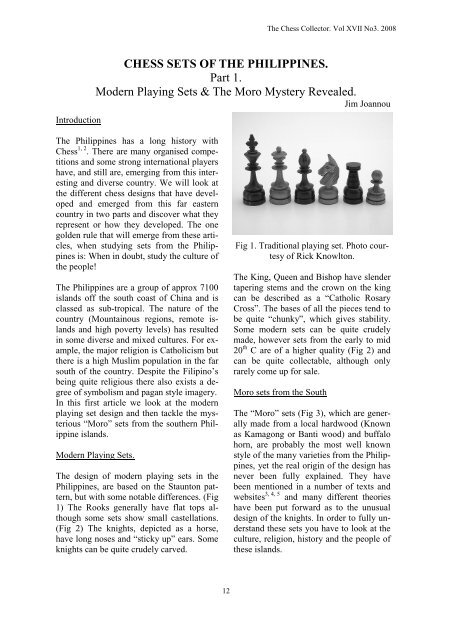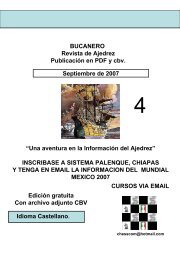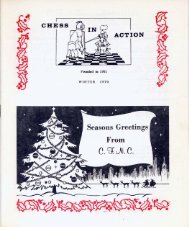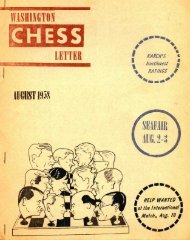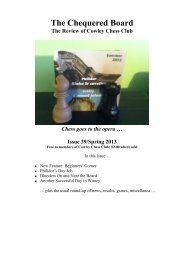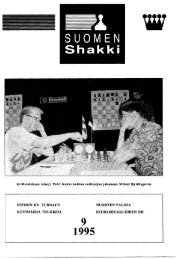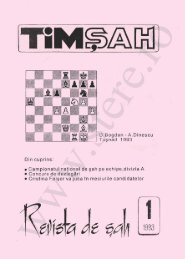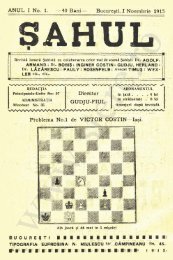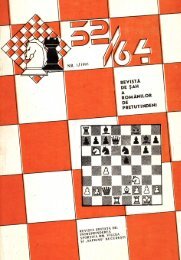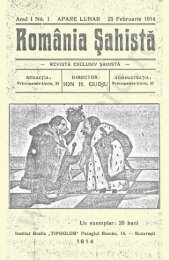The Chess Collector
El ajedrez es un juego, considerado un deporte, entre dos personas, cada una de las cuales dispone de 16 piezas móviles que se colocan sobre un tablero dividido en 64 escaques. En su versión de competición está considerado como un deporte.
El ajedrez es un juego, considerado un deporte, entre dos personas, cada una de las cuales dispone de 16 piezas móviles que se colocan sobre un tablero dividido en 64 escaques. En su versión de competición está considerado como un deporte.
Create successful ePaper yourself
Turn your PDF publications into a flip-book with our unique Google optimized e-Paper software.
<strong>The</strong> <strong>Chess</strong> <strong>Collector</strong>. Vol XVII No3. 2008<br />
Introduction<br />
CHESS SETS OF THE PHILIPPINES.<br />
Part 1.<br />
Modern Playing Sets & <strong>The</strong> Moro Mystery Revealed.<br />
Jim Joannou<br />
<strong>The</strong> Philippines has a long history with<br />
<strong>Chess</strong> 1, 2 . <strong>The</strong>re are many organised competitions<br />
and some strong international players<br />
have, and still are, emerging from this interesting<br />
and diverse country. We will look at<br />
the different chess designs that have developed<br />
and emerged from this far eastern<br />
country in two parts and discover what they<br />
represent or how they developed. <strong>The</strong> one<br />
golden rule that will emerge from these articles,<br />
when studying sets from the Philippines<br />
is: When in doubt, study the culture of<br />
the people!<br />
<strong>The</strong> Philippines are a group of approx 7100<br />
islands off the south coast of China and is<br />
classed as sub-tropical. <strong>The</strong> nature of the<br />
country (Mountainous regions, remote islands<br />
and high poverty levels) has resulted<br />
in some diverse and mixed cultures. For example,<br />
the major religion is Catholicism but<br />
there is a high Muslim population in the far<br />
south of the country. Despite the Filipino’s<br />
being quite religious there also exists a degree<br />
of symbolism and pagan style imagery.<br />
In this first article we look at the modern<br />
playing set design and then tackle the mysterious<br />
“Moro” sets from the southern Philippine<br />
islands.<br />
Modern Playing Sets.<br />
<strong>The</strong> design of modern playing sets in the<br />
Philippines, are based on the Staunton pattern,<br />
but with some notable differences. (Fig<br />
1) <strong>The</strong> Rooks generally have flat tops although<br />
some sets show small castellations.<br />
(Fig 2) <strong>The</strong> knights, depicted as a horse,<br />
have long noses and “sticky up” ears. Some<br />
knights can be quite crudely carved.<br />
Fig 1. Traditional playing set. Photo courtesy<br />
of Rick Knowlton.<br />
<strong>The</strong> King, Queen and Bishop have slender<br />
tapering stems and the crown on the king<br />
can be described as a “Catholic Rosary<br />
Cross”. <strong>The</strong> bases of all the pieces tend to<br />
be quite “chunky”, which gives stability.<br />
Some modern sets can be quite crudely<br />
made, however sets from the early to mid<br />
20 th C are of a higher quality (Fig 2) and<br />
can be quite collectable, although only<br />
rarely come up for sale.<br />
Moro sets from the South<br />
<strong>The</strong> “Moro” sets (Fig 3), which are generally<br />
made from a local hardwood (Known<br />
as Kamagong or Banti wood) and buffalo<br />
horn, are probably the most well known<br />
style of the many varieties from the Philippines,<br />
yet the real origin of the design has<br />
never been fully explained. <strong>The</strong>y have<br />
been mentioned in a number of texts and<br />
3, 4, 5<br />
websites and many different theories<br />
have been put forward as to the unusual<br />
design of the knights. In order to fully understand<br />
these sets you have to look at the<br />
culture, religion, history and the people of<br />
these islands.<br />
12


